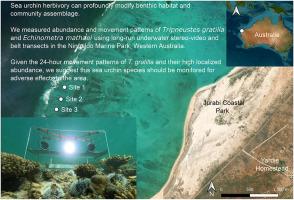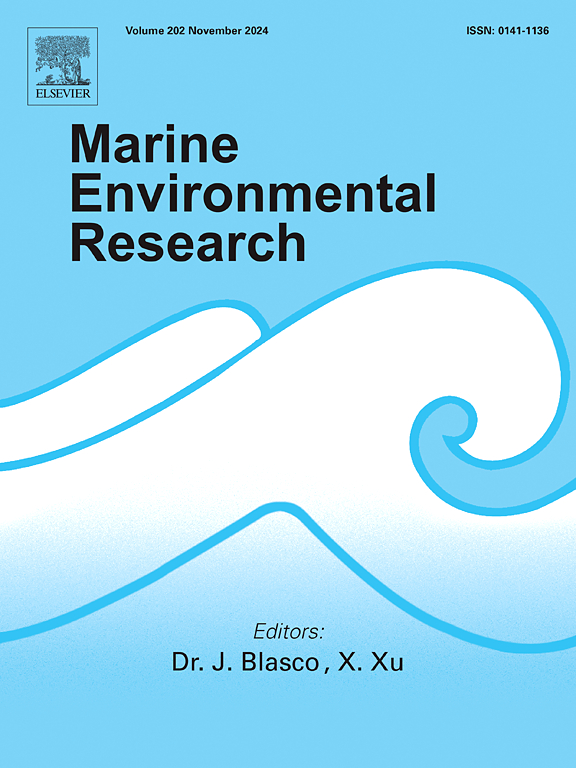Diel movement patterns and abundance of the sea urchin Tripneustes gratilla with comparisons to Echinometra mathaei and their associated ecology at Ningaloo Reef, north-western Australia
IF 3.2
3区 环境科学与生态学
Q2 ENVIRONMENTAL SCIENCES
引用次数: 0
Abstract
Sea urchin herbivory can profoundly modify the benthic habitat and community assemblage of coral reefs making their abundance and movement patterns key features to understanding the role they play in regulating community structure. This study examines the diel movement patterns of Tripneustes gratilla, with comparisons to Echinometra mathaei, and their co-occurrence with other invertebrates, at sites with a high population density on the Ningaloo Reef, Western Australia. Movement rates were measured using long-run underwater stereo-video, while density was measured using belt transects at multiple sites. The size and gut content index of Tripneustes gratilla were also investigated. We observed abundances of T. gratilla (4.29 and 6.02 individuals/m2) exceeding those from areas where outbreak densities have caused significant changes in macroalgal cover. The majority of T. gratilla were in the 60–70 mm size range, and their gut content was significantly higher when collected in the morning indicating that feeding activity may be higher during the night. We also observed greater overall movement patterns for T. gratilla than E. mathaei regardless of site or time of day, with both species exhibiting their highest movement rates at night or in the evening at sites 1 and 2, respectively. Considering the observed movement capacity of T. gratilla in this study, their relatively high abundances, and their significant grazing impact found in previous studies, this species may exert localized pressure on communities in similar habitats. Therefore, we recommend regular monitoring of both macroalgal and urchin populations on Ningaloo Reef.

在澳大利亚西北部的宁格罗礁,海胆的运动模式和丰度与棘海胆及其相关生态的比较
海胆的食草性可以深刻地改变底栖生物栖息地和珊瑚礁群落组合,使其丰度和运动模式成为了解其在调节群落结构中的作用的关键特征。本研究考察了在西澳大利亚宁格鲁礁高种群密度的地点,与棘腹鱼(Echinometra mathaei)比较,以及它们与其他无脊椎动物的共同出现的鼠笼鱼(Tripneustes gratilla)的饮食运动模式。通过长期水下立体视频测量运动速率,而在多个地点使用带样带测量密度。并对鼠笼鼠的大小和肠道内容物指数进行了研究。我们观察到格纹蝶的丰度(4.29和6.02个体/m2)超过了暴发密度导致大藻覆盖显著变化的地区。大多数格氏夜蛾的尺寸在60-70 mm之间,早晨采集的肠道含量明显较高,说明夜间的摄食活动可能较高。我们还观察到,无论在什么地点或时间,格纹田鼠的整体移动模式都比马氏田鼠大,在地点1和地点2,两种物种的移动率分别在夜间和傍晚最高。考虑到本研究中观测到的黄花蒿的移动能力、相对较高的丰度以及以往研究中发现的显著放牧影响,黄花蒿可能对相似生境的群落产生局域压力。因此,我们建议定期监测宁格鲁礁上的大型藻类和海胆种群。
本文章由计算机程序翻译,如有差异,请以英文原文为准。
求助全文
约1分钟内获得全文
求助全文
来源期刊

Marine environmental research
环境科学-毒理学
CiteScore
5.90
自引率
3.00%
发文量
217
审稿时长
46 days
期刊介绍:
Marine Environmental Research publishes original research papers on chemical, physical, and biological interactions in the oceans and coastal waters. The journal serves as a forum for new information on biology, chemistry, and toxicology and syntheses that advance understanding of marine environmental processes.
Submission of multidisciplinary studies is encouraged. Studies that utilize experimental approaches to clarify the roles of anthropogenic and natural causes of changes in marine ecosystems are especially welcome, as are those studies that represent new developments of a theoretical or conceptual aspect of marine science. All papers published in this journal are reviewed by qualified peers prior to acceptance and publication. Examples of topics considered to be appropriate for the journal include, but are not limited to, the following:
– The extent, persistence, and consequences of change and the recovery from such change in natural marine systems
– The biochemical, physiological, and ecological consequences of contaminants to marine organisms and ecosystems
– The biogeochemistry of naturally occurring and anthropogenic substances
– Models that describe and predict the above processes
– Monitoring studies, to the extent that their results provide new information on functional processes
– Methodological papers describing improved quantitative techniques for the marine sciences.
 求助内容:
求助内容: 应助结果提醒方式:
应助结果提醒方式:


